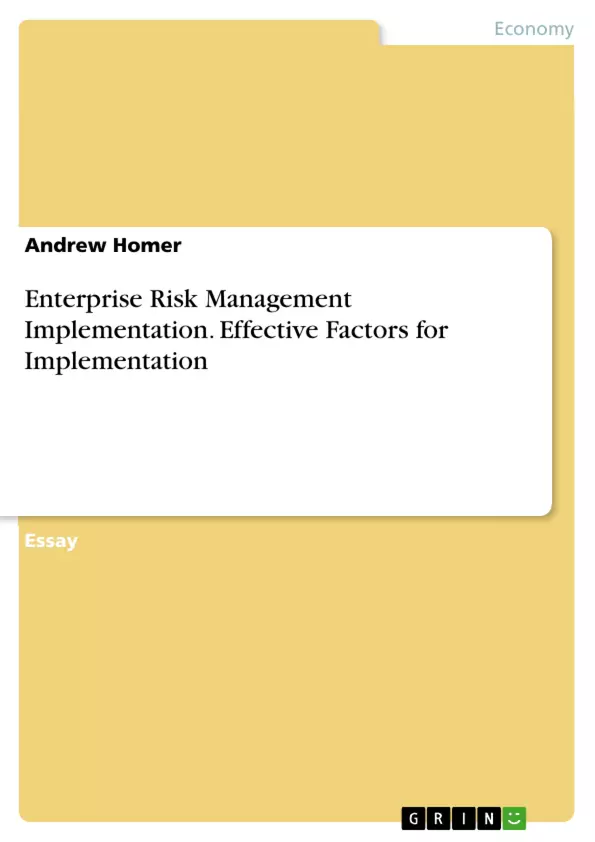This paper explores the challenges and considerations surrounding the implementation of Enterprise Risk Management (ERM) within organizations. The research delves into the evolving landscape shaped by technological advancements, global competition, and a volatile business environment. In response to these dynamic forces, organizations have increasingly recognized the importance of robust risk management practices, specifically ERM, to navigate uncertainties and create value.
While the benefits of ERM are acknowledged by many, the paper highlights a notable discrepancy between organizations actively adopting and effectively implementing ERM and those facing challenges or outright failures in its execution. The case of Countrywide Mortgage serves as a cautionary example, demonstrating that even entities previously lauded for effective ERM can face dire consequences, such as near-bankruptcy.
The paper suggests that the transition from Traditional Risk Management (TRM) to ERM is not a guaranteed formula for success. Some organizations experience significant increases in value with TRM, and the substantial financial investment required for a cultural shift towards ERM may not necessarily translate into strategic risk management. It emphasizes the pivotal role of organizational culture and the characteristics of individuals involved in ERM implementation as influential factors in determining success or failure.
The structure of the paper is outlined, including an executive summary, literature review, findings and conclusions, recommendations, and a reference section. The introduction provides a glimpse into the shifting landscape of risk management, setting the stage for a comprehensive exploration of the intricacies surrounding ERM implementation. The subsequent sections delve into a literature review, highlighting key concepts such as strategic risk, agency theory, and organizational culture in relation to ERM. The paper concludes with findings, recommendations, and implementation strategies.
Overall, the research aims to contribute valuable insights into the complexities of ERM implementation, offering recommendations for organizations to navigate challenges effectively and enhance their risk management practices in an ever-evolving business environment.
Inhaltsverzeichnis (Table of Contents)
- Executive Summary
- Introduction.
- Literature review..
- Enterprise Risk Management (ERM)
- Strategic Risk....
- Agency Theory and ERM..
- Organizational Culture and ERM.
- Findings and Conclusions.
- Recommendations and Implementation......
- References.
Zielsetzung und Themenschwerpunkte (Objectives and Key Themes)
This research explores the factors influencing the effective implementation of Enterprise Risk Management (ERM) within organizations. The study aims to understand the challenges and opportunities associated with ERM adoption, particularly in the context of the financial crisis of 2008 and the need for more robust risk management practices.
- The role of organizational culture in facilitating or hindering ERM implementation.
- The influence of agency theory on ERM adoption and effectiveness.
- The impact of strategic risk management on organizational survival and success.
- The effectiveness of various ERM frameworks and models, such as Lego's 4-step approach.
- The challenges of integrating ERM into existing organizational structures and processes.
Zusammenfassung der Kapitel (Chapter Summaries)
- Introduction: This chapter introduces the research topic and its relevance, highlighting the increasing importance of ERM in a volatile business environment. The chapter also presents an overview of the challenges faced by organizations in effectively implementing ERM, using the example of Lego's 4-step approach.
- Literature review: This chapter delves into the theoretical underpinnings of ERM, exploring key concepts such as strategic risk, agency theory, and organizational culture. It examines the impact of these concepts on ERM implementation and effectiveness, drawing on relevant literature and case studies.
Schlüsselwörter (Keywords)
This research focuses on the interplay between organizational culture, agency theory, and strategic risk management in the context of Enterprise Risk Management (ERM) implementation. Key concepts include ERM frameworks, traditional risk management, organizational culture, agency theory, strategic risk, and the impact of the financial crisis of 2008.
- Quote paper
- Andrew Homer (Author), 2016, Enterprise Risk Management Implementation. Effective Factors for Implementation, Munich, GRIN Verlag, https://www.grin.com/document/937200



